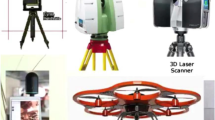Abstract
Taking the complex landform of Tanxi Mountain Landscape Bridge as an example, the application of 3D laser scanning technology in the mapping of complex rock foundations is studied in this paper. A set of 3D laser scanning technologies are formed and several key engineering problems are solved. The first is 3D laser scanning technology of complex landforms. 3D laser scanning technology is used to obtain a complete 3D point cloud data model of the complex landform. The detailed and accurate results of the surveying and mapping decrease the measuring time and supplementary measuring times. The second is 3D collaborative modeling of the complex landform. A 3D model of the complex landform is established based on the 3D point cloud data model. The super-structural foundation model is introduced for 3D collaborative design. The optimal design plan is selected and the construction progress is accelerated. And the last is finite-element analysis technology of the complex landform foundation. A 3D model of the complex landform is introduced into ANSYS for building a finite element model to calculate anti-slide stability of the rock, and provides a basis for the landform foundation design and construction.













Similar content being viewed by others
References
Dang, X. (2011). The research and application of 3D laser scanning techniques in building deformation monitoring. Xi’an: Changan University.
Zhang, W. (2011). Information processing method on rock mass structural and its application in geological engineering based on three-dimensional laser scanning technique (pp. 1–79). Cheng du: College of Environment and Civil Engineering, Chengdu University of Technology.
Kim, M.-K., Cheng, J. C. P., Sohn, H., & Chang, C.-C. (2015). A framework for dimensional and surface quality assessment of precast concrete elements using BIM and 3D laser scanning. Automation in Construction, 49, 225–238.
Luo, H. (2016). Research on 3D model reconstruction technology of ground laser scanning. Shanghai: East China University of Science and Technology.
Chen, H., & Guo, W. (2016). Application of three dimensional laser scanning technology in bridge deformation monitoring. Modern Surveying and Mapping, 39(1), 36–39.
Wang, Z., & Fei, Y. (2016). Application of a terrestrial laser sacanner to the study of rockfall monitoring. Hydrogeology and Engineering Geology, 43(1), 124–129.
Lei, C., Fenglu, Z., & Lin, Q. (2017). Study on complex shaped building measurement based on 3D laser scanning system. Bulletin of Surveying and Mapping, 1, 112–114.
Qin, R., & Gruen, A. (2014). 3D change detection at street level using mobile laser scanning point clouds and terrestrial images. ISPRS Journal of Photogrammetry and Remote Sensing, 90, 23–35.
Kim, C., Son, H., & Kim, C. (2013). Automated construction progress measurement using a 4D building information model and 3D data. Automation in Construction, 31, 75–82.
Moisan, E., Charbonnier, P., Foucher, P., & Koehl, M. (2015). Adjustment of sonar and laser acquisition data for building the 3D reference model of a canal tunnel. Sensors, 15(12), 31180–31204.
Francioni, M., Salvini, R., Stead, D., & Litrico, S. (2014). A case study integrating remote sensing and distinct element analysis to quarry slope stability assessment in the Monte Altissimo area, Italy. Engineering Geology, 183, 290–302.
Lindenbergh, R., & Pietrzyk, P. (2015). Change detection and deformation analysis using static and mobile laser scanning. Applied Geomatics, 7(2), 65–74.
Travelletti, J., Malet, J.-P., & Delacourt, C. (2014). Image-based correlation of laser scanning point cloud time series for landslide monitoring. International Journal of Applied Earth Observation and Geoinformation, 32, 1–18.
Leonov, A., & Anikushkin, M. (2014). Laser scanning and 3D modeling of the Shukhov hyperboloid tower in Moscow. Journal of Cultural Heritage, 16(4), 551–559.
Sahin, C., Alkis, A., et al. (2012). Producing 3D city model with the combined photogrammetric and laser scanner data in the example of Taksim Cumhuriyet square. Optics and Lasers in Engineering, 50(12), 1844–1853.
CH/Z3017-2015 Technical specifications for terrestrial three-dimensional laser scanning. Beijing: SinoMaps Press, 2016.1.
Leica ScanStation C10/C5 User manual (5 edition). Leica Geosysytems.
Shen, M. (1999). Rock mechanics (pp. 38–39). Shanghai: Tongji University Press.
Xiao, S., et al. (1987). Rock mechanics (pp. 69–74). Beijing: Geological Publishing House.
Engineering Geological Exploration Report on Viewing Tower and Glass Pedestrian Bridge of Tanxi Mountain in Zibo (CHY-DK-02-2015). Shandong geological surveying and mapping institute, 2015.11.
Acknowledgements
The paper is supported by the Science and Technology Commission of Shanghai, Research on technology of assembled integrated concrete for residential building design (No. 15DZ1203503).
Author information
Authors and Affiliations
Corresponding author
Rights and permissions
About this article
Cite this article
Junjie, M., Dan, L. & Zhilong, L. Application of 3D Laser Scanning Technology in Complex Rock Foundation Design. 3D Res 8, 34 (2017). https://doi.org/10.1007/s13319-017-0144-9
Received:
Revised:
Accepted:
Published:
DOI: https://doi.org/10.1007/s13319-017-0144-9




